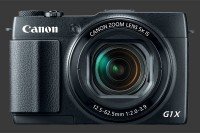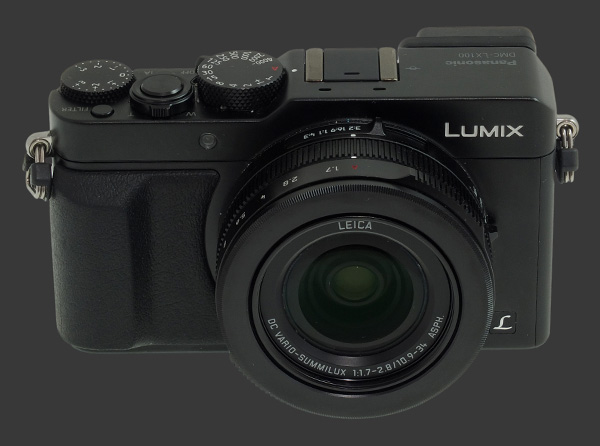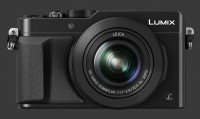Panasonic Lumix DMC-LX100 Review
Panasonic Lumix DMC-LX100 Performance - How well does it take pictures?
Ultimately, a camera is only as good as the photographs it produces. For this reason, the ratings in our digital camera reviews is based primarily on image-quality. The Panasonic Lumix DMC-LX100 is a rare premium digital camera to combine a large sensor with a bright optical zoom. This makes it possible to deliver superb images while remaining highly versatile.
The LX100 takes a 16 megapixels Four-Thirds CMOS sensor and extracts 10 - 12.5 megapixels from it capture high-resolution photographs at multiple aspect-ratios. This sensor, being shared with current Micro Four-Thirds mirrorless, is capable of high-quality output, albeit at slightly smaller print-sizes since its edges are not entirely used in the LX100.

Given its relatively compact size, this digital camera competes directly with other premium offerings rather than mirrorless ones. Among those, those few that offer larger sensors have limiting prime lenses. With exception to the Canon Powershot G1 X Mark II
Canon Powershot G1 X Mark II, every other one with a zoom uses a sensor at least 50% smaller linearly. That means at least 4X less light-gathering ability which is the primary indicator of image-quality.
Image-noise is virtually absent from ISO 100 to 800. At 12 megapixels, moderately large prints up to 18" x 12" appear impeccable. ISO 1600 shows a very slight noise-pattern while maintaining fine-details exceptionally well. This noise is unlikely to be visible at less than 100% magnification.
ISO 3200 is surprisingly similar. It only slightly more noise than ISO 1600 and fine-details are still well-preserved. One can easily make a medium-sized print from this output. Even large prints look good from a slight distance. SIO6400 is visibly noisy yet still good enough for common print sizes.
At ISO 12800, images have more noise but most of it is luminance noise. Details become visibly softer due to noise-reduction. Mid-size prints appear quite reasonable although will show mushy details upon close inspection. As one would expect, ISO 25600 is notably worse. Still, it does not show much softness and can be used for small prints without much concern.
Noise-Reduction is controllable in 11 steps, with the middle default of 0 being slightly aggressive. Tuning Noise-Reduction down to -2 improves output considerably, maintaining a good balance between image-noise and preservation of details.

Colors of the Panasonic LX100 are problematic for those shooting JPEG images. Despite numerous Photo Styles and image-parameters, colors never look real and are always too red. Closest colors are obtained using Neutral style with Saturation at -1. In Neutral style, the default Contrast is somewhat dull. Pushing it to +1 corrects things without much effect on dynamic-range.
White-Balance is much improved in the LX100 compared to preview premium Panasonic cameras. The AWB setting is still not great but produces much more neutral results overall. Under artificial lighting, it struggles more than usual, often leaving a strong yellow cast. Combined with the fact that colors are too red, this can produce an unusual an orange tint. Custom WB works very well though, so the AWB issue is avoidable with time and discipline.
The Multi-Segment metering of this digital camera is good. Most exposures are well balanced and clipping only occurs regularly in the presence of small bright highlights. The metering system balanced such that it will over-exposure slightly more frequently than under-expose. This produces more print-ready images at the expect of more lost highlight details.
The dynamic-range of this Panasonic is outstanding. That it rivals mirrorless cameras in such a compact size puts it ahead of nearly every other premium compact. For scenes which exceed the dynamic-range of its sensor, the LX100 has one of the best Built-in HDR implementation. It produces a nicely blended image from 3 exposures without weird tonalities often seen in HDR images.

The Leica DC Vario-Summilux lens on the LX100 is its crowning achievement. It manages to cover a 2.2X crop-factor while delivering an ultra-bright F/1.7 maximum aperture at wide-angle which diminishes just over one stop to F/2.8 after zooming 3.1X optically. The lens barrel goes from 2½" at wide angle to just 3¼" at telephoto and collapses down to 1 1/8" when off. There simply are no similarly specified lenses!
Optically, this lens is impressive. It shows excellent sharpness in the center at all focal-length and apertures. Edges are certainly soft wide-open, gradually sharpening towards the middle. One stop down from wide-open, there is still some softness along edges but not enough to be visible in common print sizes. Starting at F/4 near wide angle and F/5.6 near telephoto, it becomes sharp edge-to-edge.
Short lenses such as this 24-75mm F/1.7-2.8 tend to show some distortion and the one on the LX100 is no exception. From 24 to 30mm, there is a small but noticeable amount of barrel distortion. Zooming in further, straight lines always appear straight.
There is absolutely no sign of vignetting or chromatic aberrations. Panasonic usually corrects for these in software and the LX100 appears to do an excellent job at it. This lens is also remarkably resistent to flare, which is great because it has no hood nor provision to add one.
Unlike the smaller LX7, the LX100 does not feature a built-in ND filter. However, there is a 43mm filter-thread at the front of the lens. No word on compatibility though and some filters may cause vignetting which the camera would not be capable of correcting.
Once on, the Lumix LX100 is generally quite responsive. The camera starts reacting immediately to most button presses and continues to do so while it writes to the memory card. For long exposures, the camera optionally employs dark-frame substraction which locks it up for a duration equal to the exposure time. A nice touch is that the LX100 counts down the exposure time and the dark-frame substraction time, so the photographer knows how much patience is needed.
The performance of this compact digital camera is characterized by the following measurements:
- Power On: 2s. Average.
- Autofocus: Mostly under ¼s. Up to ½s in very low-light. Superb.
- Zoom: 3s from wide to tele. Glacially slow considering its short 3.1X zoom.
- Image Shutter-Lag: Instant. Excellent.
- Video Shutter-Lag: 1s. Below average.
- Black Out: ¼s. Excellent.
- Shot-to-Shot speed: Just over ½s. Very good.
- Time-to-first shot: 2½s. Good considering most of that time is spend powering on.
- Playback: ½s to exit. ½s to enter when last file is a still, 2s when it is a video.
- Power Off: 3s. Slow. This is from wide-angle. It takes longer with the lens zoomed in.
The Panasonic Lumix DMC-LX100 is truly fast where it counts the most.. Autofocus and shot-to-shot speeds are particularly good. The zoom speed could really stand to be improved though. Other below average aspects are of minor importance to photographers.
Battery-life of the Panasonic LX100 is quoted as 350 shots-per-charge, according to the CIPA measurement standard. This number is highly optimistic and with prefocus, stabilization and image review turned on, the LX100 falls slightly short of it. This is on the below average, so a second battery is recommended for long days of photography.
Panasonic Lumix DMC-LX100 Performance - How well does it shoot video?
The Panasonic Lumix DMC-LX100 can record Ultra-HD video, which is also known as 4K and is 4X the resolution of full HD. That means each frame is 3840x2160. It can capture 4K video at 30 or 24 FPS and is currently the smallest digital camera to do so. It can also record 1080p at 60 FPS, for those not ready to jump to Ultra-HD yet.
Ultra-HD video is recorded at 100 Mbps using a standard MPEG-4 format and codec. This requires the use of a fast SDHC or SDXC memory card. Full HD can be record at 28, 24 or 20 Mbps, so it uses 4-5X less bandwidth and storage space. For 1080p, the LX100 also supports the less-common AVCHD format.
Focus during video can be single-shot, continuous or manual. AF-S is repeatable while recording but is extremely slow. AF-C is available but should not be relied upon as it can easily hunt or pickup the wrong subject.

The Panasonic LX100 has no modes at all. Everything is implicit which also includes video. Capture starts and stops with a press the the dedicated Video Record button. Like HD, 4K has a 16:9 widescreen aspect-ratio. One can select the same aspect-ratio using the slider on top of the lens barrel but it sadly does not match exactly the framing of 4K video. There is no way to correctly preview video-framing on this camera.
Manual-controls are available for video just as easily as for stills. The aperture-ring and shutter-speed dials can be set to A or a specific shutter-speed. The EC dial applies and ISO can be changed while video is being recorded. One can obviously not set the shutter-speed to something longer than the frame-rate. Sensitivity though is restricted to the an ISO 200-6400 range.
Video quality of the Panasonic Lumix DMC-LX100 is top-notch. Frames show fine details with few compression artifacts. Noise-levels are quite low thanks to the 16 MP Four-Thirds sensor which outputs about 8 MP per Ultra-HD frame. This allows better resampling than most digital cameras when scaling down the sensor-output to video-resolution.
There is an unfortunate 1s lag to the Video Record button. This causes the first second of action to be missed and one extra second of footage at the end. This is certainly not idea but is typical of cameras which do not have a dedicated Video mode. With a fast memory card, the LX100 clears the recording buffer quickly. There is a short delay though when playing back 4K video. It is noticeable but not crucial.
Panasonic Lumix DMC-LX100 Conclusion

The Panasonic Lumix DMC-LX100 is an entirely new premium digital camera. It combines the same sensor-size as Panasonic mirrorless cameras with an ultra-wide and ultra-bright 3.1X optical zoom lens into a relatively compact body.
The LX100 truly achieves an unprecedented balance of image-quality, size and versatility with its multi-aspect-ratio 2.2X-crop sensor and quality Leica optics. Image-noise, exposure, dynamic-range and sharpness are all very good, while color and white-balance could use some improvement yet are fixable by shooting RAW or using basic image-processing.
This premium camera is exceptionally fast with a very quick shutter-lag and speedy autofocus system. Shot-to-shot speeds are also great, leaving only a really slow zoom and short video-recording lag to complain about in terms of speed. Video performance otherwise is good, delivering high-quality output with fine details and smooth motion.
The LX100 provides a high number of direct controls, including dedicated dials for aperture, shutter-speed and exposure-compensation. A control-ring, aspect-ratio selector, generic control-dial and several customizable buttons complete the interface, making all important photographic functions easily accessible. Given its compact size, some controls are crowded and prone to accidental changes.
Overall, the Panasonic Lumix DMC-LX100 delivers a unique and solid premium digital camera experience. There is no doubt this is an excellent and highly capable camera, earning it the highest rating of any Panasonic digital camera for its class-leading combination of image-quality, performance and ergonomics.
 |
Please Support Neocamera
All information on Neocamera is provided free of charge yet running this website is a huge endeavor. Purchases made via affiliate links found throughout the site help keep it running and up-to-date. There is no additional cost to you, so please consider buying via these links to our affilates:
If you found any information on this site valuable and did not purchase via our affiliate links, please considering donating via PayPal:
Any amount will be greatly appreaciated. Thank you for your support!
Panasonic DMC-LX100 Highlights

Sensor-Size: 17 x 13mm

Actual size when viewed at 100 DPI
| 12 Megapixels Fixed Lens | ISO 100-25600 |
| 3.1X Ultra-Wide Optical Zoom | Shutter 1/16000-60s |
| Built-in Stabilization | Full manual controls, including Manual Focus |
| 0.38" Built-in EVF 2.8 Megapixels (0.70X) | Custom white-balance with 2 axis fine-tuning |
| Automatic Eye-Start sensor | Spot-Metering |
| 2 Axis Digital Level | Hot-Shoe |
| 11 FPS Drive, 8 Images | Lithium-Ion Battery |
| 3840x2160 @ 30 FPS Video Recording | Secure Digital Extended Capacity |
| 3" LCD 920K Pixels |
Updates
2024.11.18

Best 2024 Photography Gifts for Every Budget
Great gifts for photographers and photo enthusiasts selected for every budget among the best products of 2024.
2024.08.07

Eye Protection Tips for Professional Photographers
The four main considerations for professional photographers regarding eyewear.
2024.07.14

Fujifilm X100VI Review
Flagship fixed-lens compact digital camera with a 40 MP sensor and Image-Stabilization, a first for the series. Retro design featuring dual control-dials, plus direct ISO, Shutter-Speed and EC dials. Its hybrid viewfinder can switch between EVF and OVF mode.
2024.05.09

Fujifilm GFX100 II Review
Flagship 102 Megapixels Medium-Format Mirrorless Digital Camera with 8-Stop 5-Axis IBIS, 8 FPS Drive, 8K Video and 400 MP Super-Resolution capture in a weatherproof and freezeproof body with dual control-dials and dual memory-card slots.
2024.04.03

Fujifilm X-T5 Review
Newest Fujifilm flagship boasting a 40 MP APS-C sensor, 5-axis IBIS with 7-stop efficiency, 15 FPS continuous drive, 6.2K Video capture, dual control-dials and dual SDXC UHS-II slots in a sturdy weatherproof and freezeproof body.
2023.11.20

Best Digital Cameras of 2023
Find out which are the Best Digital Cameras of 2023. All the new Mirrorless Digital Cameras from entry-level to high-end professional.
2023.07.10

Fujifilm X-H2 Review
40 Megapixels APS-C Hybrid Mirrorless Digital Camera with 7-stop IBIS. Fastest shutter ever and 8K video capture. Large builtin EVF with 0.8X magnification and 5.8 MP, plus an Eye-Start Sensor. Packed with features and large number of controls in a weatherproof and freezeproof body.
2023.05.07

Sony FE 20-70mm F/4G Review
Review of the unique Sony FE 20-70mm F/4G lens. The optical zoom of this lens spans ultra-wide-angle and medium focal-length coverage, making it one of the most versatile Full-Frame lenses on the market.
2023.01.15

Huion Inspiroy Dial 2 Review
Review of the Huion Inspiroy Dial 2 tablet, a medium sized drawing surface with dual dials and customizable buttons. Connects via USB-C or Bluetooth 5.0 with Windows, Linux and Android support.
2022.12.08

How to Pack for a Photo Trip
Find out how to pack for a travel photography trip, carry your gear safely while meeting airline regulations.
2022.11.13

Best Digital Cameras of 2022
The best digital cameras of 2022. A short list of the most outstanding models in their respective categories. Choose one for yourself or as a gift.
2022.09.21

Pentax DA* 60-250mm F/4 SDM Review
Review of the Pentax DA* 60-250mm F/4 SDM, the constant-aperture telephoto zoom with the highest zoom-ratio on the market.












